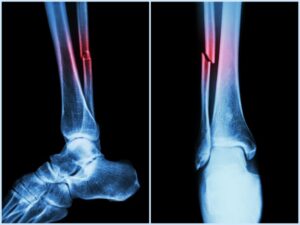This guide will help you understand when you could seek compensation for the avoidable harm you sustained after receiving a delayed ankle fracture diagnosis. All medical professionals owe a duty of care to their patients. If this is breached, it could result in you experiencing unnecessary harm. In these instances, you may be eligible to seek compensation. We aim to give you the information you need to understand how and when you could make a medical negligence claim.

Delayed ankle fracture diagnosis claims guide
Additionally, we shall discuss how an ankle fracture could be misdiagnosed and the impact this could have.
Furthermore, we will look at the potential compensation amounts you could receive following a successful claim.
If you have evidence that you’ve been harmed due to medical negligence and would like further guidance, you can contact us. Our advisors are able to provide you with free legal advice 24 hours a day, 7 days a week.
To contact our advisors, you can:
- Call on 0800 652 3087
- Contact a member of our team via our online form.
- Chat with an advisor using the chat feature on the bottom right of your page.
Select A Section
- What Is A Delayed Ankle Fracture Diagnosis?
- How Could Ankle Fractures Be Diagnosed?
- Can Fractures Be Missed On An X-Ray?
- Eligibility To Claim For A Delayed Ankle Fracture Diagnosis
- Delayed Ankle Fracture Diagnosis Claim Calculator
- Talk To Us About Your Delayed Ankle Fracture Diagnosis Claim
What Is A Delayed Ankle Fracture Diagnosis?
A delayed ankle fracture diagnosis is when a patient’s broken ankle does not get diagnosed and is therefore left untreated. The NHS states the following symptoms could be an indication of a broken ankle:
- It is painful, swollen or bruised.
- It hurts when you put weight on the ankle.
- The ankle feels stiff and hard to move.
Additionally, they state that you should go to A&E if you’ve injured your ankle and:
- A bone is sticking out of the ankle.
- You’re in severe pain.
- Your toes feel numb or look white or blue.
In order to make a valid claim following a delayed fracture diagnosis, you will need to prove that you suffered avoidable harm because a healthcare professional breached their duty of care. We shall discuss the duty of care they owe in more detail later on this guide.
Call our advisors today for more information regarding a delayed diagnosis.
How Could Ankle Fractures Be Diagnosed?
According to the NHS, ankle fractures are usually diagnosed via an X-Ray. This X-Ray can also show how bad the break is, and from that, a medical professional can determine what treatment you may need.
Minor breaks may not require any treatment, whereas more serious breaks may need various treatments, such as:
- A special boot that helps support your ankle.
- Your ankle is placed into a plaster cast whilst it heals.
- A doctor moving the bones back into place.
- Surgery to fix the broken bones.
Post-treatment, you may have routine follow-up appointments to ensure that the ankle is healing properly.
However, if you received a delayed diagnosis of your ankle fracture, this could lead the break to worsen. As such, you may experience complications due to not receiving treatment for your injury.
Call our advisors today for more information regarding a delayed fracture diagnosis and whether you could be eligible to seek compensation.
Can Fractures Be Missed On An X-Ray?
There are various factors that could contribute to a delayed ankle fracture diagnosis, including:
- An X-Ray not being performed due to a doctor ignoring clear symptoms of a fracture that you exhibited. This could result in the fracture being misdiagnosed as a sprain or strain. As such, there is a delay in you receiving the correct diagnosis.
- A medical professional misreading an X-Ray scan. As a result, they don’t see the fracture and fail to diagnose you.
If you have experienced a similar incident, contact our advisors today to find out whether you have a valid medical negligence claim.
Eligibility To Claim For A Delayed Ankle Fracture Diagnosis
As we have stated towards the beginning of this guide, in order to make a valid claim following a delayed fracture diagnosis, you will need to prove that you suffered avoidable harm due to a medical professional breaching their duty of care.
All medical professionals, including doctors, nurses, pharmacists and surgeons, owe their patients a duty of care. Regardless of whether they work for the public or private healthcare sector, they must ensure that their patients are receiving the correct standard of care. This is the duty of care that they owe you and is applicable in various medical environments, including hospitals, care homes and pharmacies.
However, if a medical professional provided care that fell below the correct standard, they may be in breach of their duty of care. If you experience avoidable or unnecessary harm as a result, this is known as medical negligence.
If you have evidence that you’ve been harmed due to medical negligence, you may have grounds to claim.
Call our advisors today for more guidance regarding eligibility for making a delayed ankle fracture diagnosis claim.
Delayed Ankle Fracture Diagnosis Claim Calculator
A delayed ankle fracture diagnosis can be uncomfortable and could disrupt your daily activities. If you make a successful medical or clinical negligence claim, your settlement could consist of general and special damages.
General damages compensate for the harm you have endured due to medical negligence.
It is important to note that you can only claim compensation for the harm caused by medical negligence and not the initial ankle fracture itself.
Many solicitors will use a document called the Judicial College Guidelines (JCG) to assist them in valuing general damages.
With this in mind, we have created the following table using the figures listed in the most recent edition of the JCG, published in April 2022. You should only use these amounts as a guide, as the specific circumstances of your case will influence how much you could be awarded.
| Injury | Notes | Amount |
|---|---|---|
| Ankle Injuries | (a) Very Severe - The ankle is deformed due to a transmalleolar fracture and extensive soft-tissue damage. | £50,060 to £69,700 |
| Ankle Injuries | (b) Severe - An injury that causes significant residual disability in the form of ankle instability and limited ability to walk. May also require time in plaster. | £31,310 to £50,060 |
| Ankle Injuries | (c) Moderate - Fractures and ligamentous tears which make it difficult to walk on uneven ground or other less serious disabilities. | £13,740 to £26,590 |
| Ankle Injuries | (d) Modest - Less serious, minor or undisplaced fractures in the ankle are included in this bracket. | Up to £13,740 |
| Achilles Tendon | (a) Most Serious - Restricted ankle movement with cramping and swelling due to the severance of the tendon and peroneus longus muscle. | In the region of £38,430 |
| Achilles Tendon | (b) Serious - Residual weakness, a limp and limited ankle movement following the successful repair of a complete tendon division. | £24,990 to £30,090 |
| Achilles Tendon | (c) Moderate - Cases in this bracket include a partial tendon rupture or other significant tendon injury. | £12,590 to £21,070 |
| Achilles Tendon | (d) Minor - Tendon is slightly damaged due to turning of the ankle. | £7,270 to £12,590 |
| Foot Injuries | (d) Severe - Both heels have suffered fractures that cause permanent pain and other issues. | £41,970 to £70,030 |
| Foot injuries | (f) Moderate - Permanent deformity and ongoing issues due to displaced metatarsal fractures. | £13,740 to £24,990 |
Special damages, on the other hand, compensate for the past and future financial losses you have accrued due to the harm caused by medical negligence. Special damages could compensate you for various things, including:
- Travel expenses to and from medical appointments.
- Paying for private care.
- Lost wages if you had to take time off work.
You will need to provide evidence of this suffering, such as receipts or invoices.
Contact our advisors today for some free legal advice regarding your claim. An advisor can also discuss the compensation you could receive following a successful claim.
Talk To Us About Your Delayed Ankle Fracture Diagnosis Claim
A solicitor from our panel could represent your medical negligence claim under a No Win No Fee agreement. There are many types including a Conditional Fee Agreement (CFA).
With this type of arrangement, you will not pay anything upfront or ongoing to your solicitor for their services. Additionally, if your claim is not successful, you will not have to pay your solicitor anything for their services.
Alternatively, if your claim is successful, a small percentage of your compensation (known as a success fee) will be paid to your solicitor. However, this amount is capped by law.
If you have further questions about making a claim following a delayed ankle fracture diagnosis, do not hesitate to reach out to our advisors. They can give you free legal advice and answer any of your questions regarding the medical negligence claims process.
To contact our advisors, you can:
- Call on 0800 652 3087
- Contact a member of our team via our online form.
- Chat with an advisor using the chat feature on the bottom right of your page.
Medical Negligence Resources
Below, we have included more medical negligence articles:
- How much could my medical negligence claim be worth?
- £60,000 missed fracture compensation amount payout
- Wrongful death negligence compensation claims
Additionally, we have included some external resources that you might find beneficial:
- NHS Resolution – Annual report statistics
- Care Quality Commission (CQC) – Report a concern if you are a member of the public
- UK GOV – NHS constitution for England
Call our advisors today to discuss whether you could claim for a delayed ankle fracture diagnosis.
Writer Megan Riker
Editor Meg Miller
